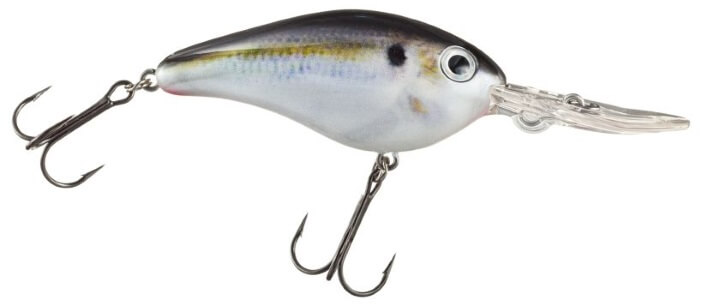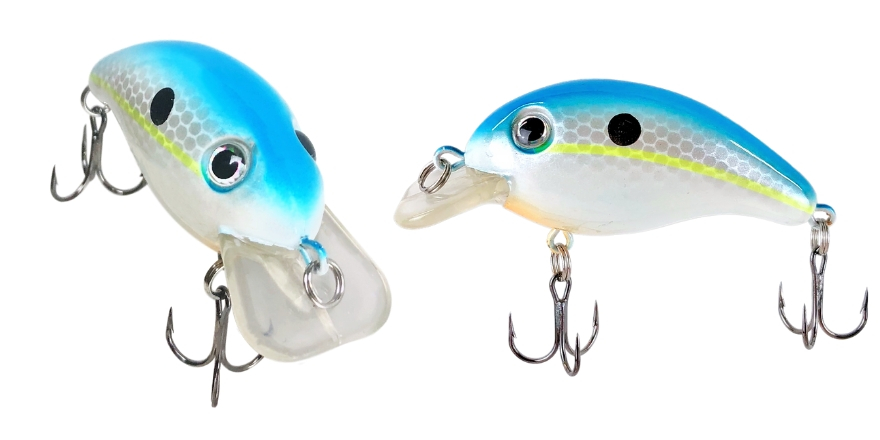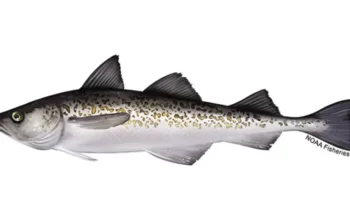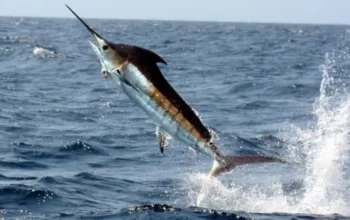A crankbait is a type of fishing lure that is typically carved from wood or made of hard plastic. It is designed to resemble a baitfish, crayfish, or other prey’s swimming motion.
Bass fishermen who need to quickly cover water and explore different depths typically use the crankbait technique. Crankbaits today come in a variety of body sizes and widths, but the lure’s bill is the primary characteristic that distinguishes a crankbait as a shallow-, medium-, or deep-diving plug. For running in the shallows from 1 to 4 feet, square-billed crankbaits work best. A plug with a 1-inch bill will dive to a depth of about 10 feet. Longer-billed crankbaits have the potential to dive to depths of 30 feet.
For more information, keep reading.
Table of Contents
What Is A Crankbait?
When it is reeled in, a crankbait, a lure with a plastic lip that dives underwater, is cast. To catch fish at particular depths, crankbaits are used. The depth to which the bait can be lowered depends on the length and inclination of the plastic lip. In comparison to short, sharply angled lips, longer, less angled lips dive deeper. Because they can effectively cover water, crankbaits are fish catching machines. To get the most coverage, you want to cast and retrieve crankbaits over a lot of water. Through a wiggling motion that can resemble a baitfish, crawfish, or fry game fish, cranks entice bites.
Types Of Crankbait
Shallow Diving Crankbaits
Lips on shallow diving crankbaits are typically smaller than lips on deeper runners. A shallow runner might also be more buoyant.
These include wakebaits. These crankbaits move only slightly above the water’s surface.
They sometimes create a “V” shaped wake as you reel them in.
These kinds of crankbaits perform admirably in shallow waters. In rivers, the can be extremely helpful.
When pursuing Smallmouth Bass, I’ve had great success using shallow running crankbaits. Smallmouth enjoy standing up and attacking them.
Shallow running crankbaits may also be used to draw fish to schools of bait. The likelihood of an attack increases if you notice little minnows jumping on the surface.
Fish predators enjoy smashing schools of bait at the surface.
You could potentially have a fantastic day on the water if you can closely match the pattern of the bait. The secret is to get as close as you can to the food that the fish are eating.
Medium Diving Crankbaits
In my region of the country, medium-diving crankbaits begin to shine in the spring when the water temperature reaches the upper 40- to low 50-degree range. Early prespawn bass can be caught on these crankbaits along the deepest part of a bluff, and as the water warms further, the end of the bluff that connects to a flat becomes the best place to crank. Medium-sized divers are at their peak when prespawn bass move to chunk rock shorelines or transition zones where the banks change from big rocks to pea gravel. In the main creeks, the deeper banks at the end are usually where the fish are.
Which type of crankbait to throw for bass in the 7- to 10-foot range depends on the clarity of the water. Wide wobbling crankbaits that can be retrieved at slow to medium speeds work best in murky water. In clear water, more bass are fooled by flat- or thin-sided crankbaits that produce a tight wiggle.
How you present the lure to prespawn bass depends on the shape of the crankbait. You ought to crank your plug all the way to the bottom to deflect it away from the rocks since wide wobbling crankbaits best mimic crawfish. On clear-water lakes, when the water temperature rises into the low 50s, prespawn bass strike at fast retrievals of thin-sided crankbaits. When baitfish are present, work the shad-impersonating crankbait over the tops, around the edges of standing timber, and along windy banks.
Most prespawn cranking situations for bass in the mid-depth zone work well with 12- to 15-pound line. However, when fishing in clear water where prespawn bass stage a little deeper, you might need to scale back to 8- or 10-pound test.
Deep Diving Crankbaits
Since bass suspend in deep water and start feeding on shad during the postspawn period, this marks the beginning of deep cranking. Fishing with crankbaits requires a thorough understanding of the spawn. A deep-diving crankbait offers some heavyweight bass action when the summer heat is on. Reeling a magnum-size, deep-diving crankbait all day can be physically demanding, but this technique’s potential for tricking big bass makes it worth the toil and trouble
Ledges, humps, bluff ends, and channel swing points are important targets for deep cranking. Bass will move down to the bottom as the water gets warmer. Using your electronics, search for any sweet spots, such as logs, brush piles, shell beds, large boulders, etc.) on the structure and try to run your crankbait into it. More strikes will occur if your crankbait is deflected away from the sweet spot.
The crankbait can hit the sweet spot in the middle of your retrieve by diving deep enough with a long cast past your target. Use thinner line, such as 10- to 12-pound test, to enable your plugs to reach depths of 20 to 25 feet because line diameter affects a crankbait’s ability to dive.
Lipped Crankbaits
Most people simply refer to crankbaits as lips. The front of them has a metal or plastic bill. A scoop-shaped piece of plastic is the bill. It resembles the scoop of a spoon and is typically made of transparent plastic.
A crankbait’s underwater dive is brought on by this bill. The bill creates resistance as you turn the reel and drags the bait down.
The majority of crankbaits float up until they are retrieved. As a result, when you cast one out, it will float on the surface. It won’t go underwater until you start cranking it.
Suspending crankbaits are another option. These have weights installed in them to provide buoyancy that is almost neutral or neutral. An expected dive will occur as you reel in a suspending crankbait.
However, once the retrieve is stopped, it will either stay put or float up very slowly instead of rising quickly.
For their crankbaits to suspend, some anglers add weights.
Although they are uncommon, I have also seen sinking lipped crankbaits.
Crankbait Action
As it travels through the water, the crankbait sways. The crankbait appears to be swimming or moving through the water as a result of this illusion. Predatory fish focus on and react to this swaying because it is a crucial aspect.
The bait keeps diving as you drag it through the water until it reaches the bottom and is unable to dive any deeper. Typically, buoyancy and upward resistance determine where that point is. Depending on the line you’re using, there may be changes in upward resistance.
Braided line floats, as an illustration. A crankbait will encounter much greater upward resistance as a result. However, fluorocarbon line sinks. This makes it a much better option for crankbait fishing. A crankbait can dive to its maximum depth with fluro line.
A crankbait will travel at the same depth for a short distance after reaching its maximum depth. It will then begin to rise to the surface. The crankbait will finally touch the end of your rod.
Lipless Crankbaits
The bill or lip on the front of a lipless crankbait is absent. They are designed to sink because they lack a lip that would cause them to dive.
Internal bbs that also serve as noise makers frequently weigh them down. Predators will be drawn to the bait by the noise the bbs inside make. Because of this, lipless crankbaits are sometimes referred to as rattlebaits.
Crankbaits without lips are frequently cast more quickly and ripped through the water. They have a tighter wobble that works well for quick retrievals.
Their attachment point is at the top of the lure as opposed to the front, like a lipped crankbait. See more about What Is A Jon Boat?
Crankbait Hardware
A line tie is located at the front of a crankbait. This is a tiny metal loop that is typically located on the bait’s body, either directly above the bill or just above it.
A split ring will frequently be fastened to the metal loop. Comparable to a tiny key chain ring is a split ring. It’s an openable metal circle that can be joined to the metal loop with a little prying.
Similar to how a key ring is attached to a key, a split ring can be attached to a metal loop on a crankbait.
A crankbait’s attachment point has split rings added for a purpose. Split rings enable the crankbait to move more naturally. Friction is the reason for this.
If there was no split ring, you would be tying the knot directly to the attachment loop. Friction would result, preventing the lure from swinging back and forth across its entire range.
You tie directly onto the split ring when one is added. The wobbling is unaffected by the knot as you retrieve the lure.
In other words, the split ring enables the free swing of the crankbait.
Split rings at the attachment point are absent from some crankbaits. You can purchase aftermarket split rings and attach them to your baits in these circumstances.
Treble Hooks
A minimum of two treble hooks will also be attached to the crankbait. This is not always the case. I’ve seen some crankbaits with just one hook. But this is rare.
Metal loop attachment points support the treble hooks. The center and back of the crankbait typically contain these points.
Shad Rap by Rapala With Treble Hook Attachment Point. Replaced with a new treble hook.
The treble hooks are fastened to the attachment points on a crankbait body using split rings as well.
The stock treble hooks that come with crankbaits are frequently swapped out by anglers.
Split ring pliers are an excellent tool to have for this use.

Crankbait Shapes
The shapes of crankbaits can differ significantly. A small baitfish is one of the most typical crankbait shapes you’ll see.
It is possible for this shape to be extremely rounded or thinner. A crankbait’s wobble will depend on its width.
Wider wobbles are typical of crankbaits with an extremely rounded appearance.
On the other hand, crankbaits with a thinner profile wobble more tightly.
Anglers prefer to be able to adjust the tightness of the wobble based on the perceived mood of the fish.
Crayfish is yet another typical crankbait design. With crayfish legs, ridges on the back of the shell, and tucked-in claws, crankbaits are frequently molded.
Scales and fins may be molded or carved into some crankbaits designed to resemble bait fish.
Basic Crankbait Anatomy
Crankbait Construction
Any one of three basic materials can be used to make crankbaits. Each has advantages and disadvantages.
Wood
For the most part, lighter, high-buoyance (or fast-floating) woods are preferred for crankbait construction.
Balsa, pine, cedar, white cedar, and basswood are the ideal woods for crankbait construction.
Harder woods like maple, oak, ash, and walnut make excellent suspending lures and large swimbaits despite being more difficult to carve.
Helpful tip: “A balsa crankbait is the best tool for deflecting fish off of cover.”
The Positives
Unlike any other kind of crankbait, balsa baits can grind, float, and hunt with insane amounts of action.
Balsa wood is frequently used to make squarebill crankbaits, for instance. The wood enhances the irregular action of a squarebill crankbait and causes the bait to hunt (action in which the lure will swim widely to the right and left as if looking for food). Balsa squarebills can also leap over cover with ease.
The best advice I can give is to fish them quickly and make the bait deflect off cover to elicit reaction strikes.
The Bad
The issue of potential irregularity is a drawback of wooden baits. Because it’s a natural product, wood’s density can vary slightly.
You quickly discover that some wooden baits are really great and some don’t have very good action, especially if the lure is handmade, if you make or buy some wooden baits.
Another issue with wooden baits is their fragility. The balsa bait has a strong tendency to break if you slap it on the water. If you are stuck and pull as hard as you can on the bait, you risk ripping the wire from the line ties.
Plastic Crankbaits
The majority of contemporary crankbaits are made of ABS plastic. Plastics come in a wide range of varieties, all of which have the same advantages.
A high-quality hard plastic crankbait can be made, but the process is not simple and necessitates a number of challenging steps.
Hot plastic is first used to create the two body halves, which are then loaded with interior components like weights, rattles, hook hangers, and line ties.
Once chemically fused together to form a watertight seal, the two halves are checked for leaks and indicators of moisture retention.
Helpful tip: “Bass fishing is excellent with plastic crankbaits in the summer and early fall because they produce more sound than wooden crankbaits. “
Crankbaits made of hard plastic are typically less expensive and simpler to make. Due to the automation of the process, the weight, balance, sound, and wobbling action of each bait is consistent.
Plastic baits have less action than their wooden counterparts, despite being thought to be more durable.
Composite Crankbaits
High-density foams or PVC decking are used in the manufacture of some crankbaits.
PVC decking, such as AZEK PVC Trim Boards, is a relatively new material for making baits within the last ten or so years. Custom crankbait makers (including myself) use it most frequently.
Anglers prefer this material over alternatives like balsa for a variety of reasons.
It is totally waterproof. Without any sealing, creating a lure, determining its buoyancy, and ballasting it are straightforward processes. In my driveway, I practice my floating skills by submerging a 3-gallon pail in water.
It floats. Knowing many current Azek PVC decking trim board users, they compare it to poplar hardwood in terms of weight and ease of carving. They also claim that it floats similarly to, if not better than, a medium density balsa bait made in the same manner.
It’s strong. The trimboard, despite not being as dense, is still more than capable of supporting any crank and is just as durable as any other wood for the purpose of making lures. The PVC material also allows you to create jointed lures in addition to crankbaits of any size.
Simply drill a tiny pilot hole and twist in the screw eye to secure it; the PVC decking is strong enough to prevent the screw eyes from being pulled out. No need for any type of reinforcement, including epoxy-filled holes.
It sands, cuts, and carves exceptionally well. PVC is simple to shape with sanding. The same tools you would use for wood baits can be used; no special tools are required.
When carving details, sharp tools are ideal. Unexpectedly, because it lacks direction-oriented grain, t carves incredibly well with sharp tools.
It could be fused into bigger lure blanks using super glue or the PVC adhesive that plumbers use for PVC pipe. When the glue and PVC primer are combined, the two parts really do melt into a single, solid piece.
Painting PVC is easy. When common white airbrush paint is used as a base coat and heated to set it, lure makers never complain about paint-body separation issues.
Any finish will do. I and other lure makers have all successfully used urethanes, epoxies, and concrete sealers.
Simply put, using PVC composite decking expedites and simplifies the lure-making process, which increases enjoyment. For this reason, I and many other bait makers use it.
Bill Design
The structure extending from the nose of crankbaits is typically firm, flat, and thin. The “bill” is what we refer to as.
The bill may be constructed from metal, carbon fiber, circuit board, or clear ABS plastic.
Crankbait bills serve a variety of purposes.
- The bait is initially allowed to dive to a certain depth.
- Second, they help to create the bait’s realistic movement.
- Third, the bill will make the bait bounce off underwater objects rather than getting hung up.
Helpful tip: “The overall length of the bill and the location of its attachment to the lure dictate the diving depth.”
Unfortunately, by simply observing the bill, it is impossible to determine with any degree of accuracy how deep a crankbait will dive. The bill will, however, run straight or parallel to the body on the deepest diving crankbaits.
The bill of the shallowest running crankbaits will be more downwardly angled.
The wobble is typically wider the wider the bill.
While some crankbaits lack a bill sore, the majority do.
The ones that don’t are known as “lipless crankbaits,” and we’ll talk about those later. The remaining individuals will be categorized as “shallow,” “medium,” and “deep” divers.
Sound
A belly weight will be present on all crankbaits. To aid it in swimming naturally and upright, this is incorporated into the bait. There are some crankbaits that come with extra rattles or loose-fitting weights that can also serve as rattles.
Bass are drawn in by the crankbaits’ sound, which reverberates throughout the water.
Helpful tip: “Metals like steel or lead are typically used to make internal rattles. Glass or tungsten rattles are additional options.”
There are some crankbaits that don’t have rattles. They are called ‘silent’ crankbaits.
When bass are very shallow (like during spawn), when bass are under a lot of pressure, or when the lake is exceptionally clear, silent crankbaits are appropriate.
Crankbait Hooks
Last but not least, you’ll notice that crankbaits typically have two pointed treble hooks hanging from the bottom of the bait.
In addition to serving as the lure’s main point of contact with the water and catching fish, these treble hooks also serve as an additional weight to support the keel that is built into the lure. Further assisting the lure’s ability to swim straight.
For beginners, the only conclusion that can be drawn from those treble hooks is that it will hook itself on the first piece of wood or structure it swims over. But do not worry; the bills will frequently deflect the bait over the wood, preventing it from getting hung up.
Use Crankbait Lures For Bass
The best lures for pursuing largemouth bass are crankbaits. Typically, largemouth bass are dispersed in less than 30 feet of shallow water. Targeting bass in these shallow areas can be done effectively by casting a fast lure, such as a crankbait. Squarebill/shallow diving (0′-8′), medium diving (8′-12′), deep diving (12’+), and lipless (varies) are the four main categories for crankbaits. Select a crankbait based on the depth range you are aiming for. The fundamental idea behind crankbait fishing is casting and steadily reeling. Start your first crankbait fishing lesson with a slow to medium retrieve so your bait swims halfway down the water column. As you get better, change up your delivery. To resemble a wounded baitfish, try short pauses followed by rapid cranks. A bass nearby will be vibrated if you bump into boulders, rocks, or wood. Find a useful pattern by adjusting the speed, depth, and cadence.
Conclusion
The ability to use a crankbait is not just advised in the bass fishing world of today; it is a requirement. Learning about the various crankbait styles and how they fit into your arsenal can be overwhelming for bass fishermen who are just starting out.
We appreciate you reading.




